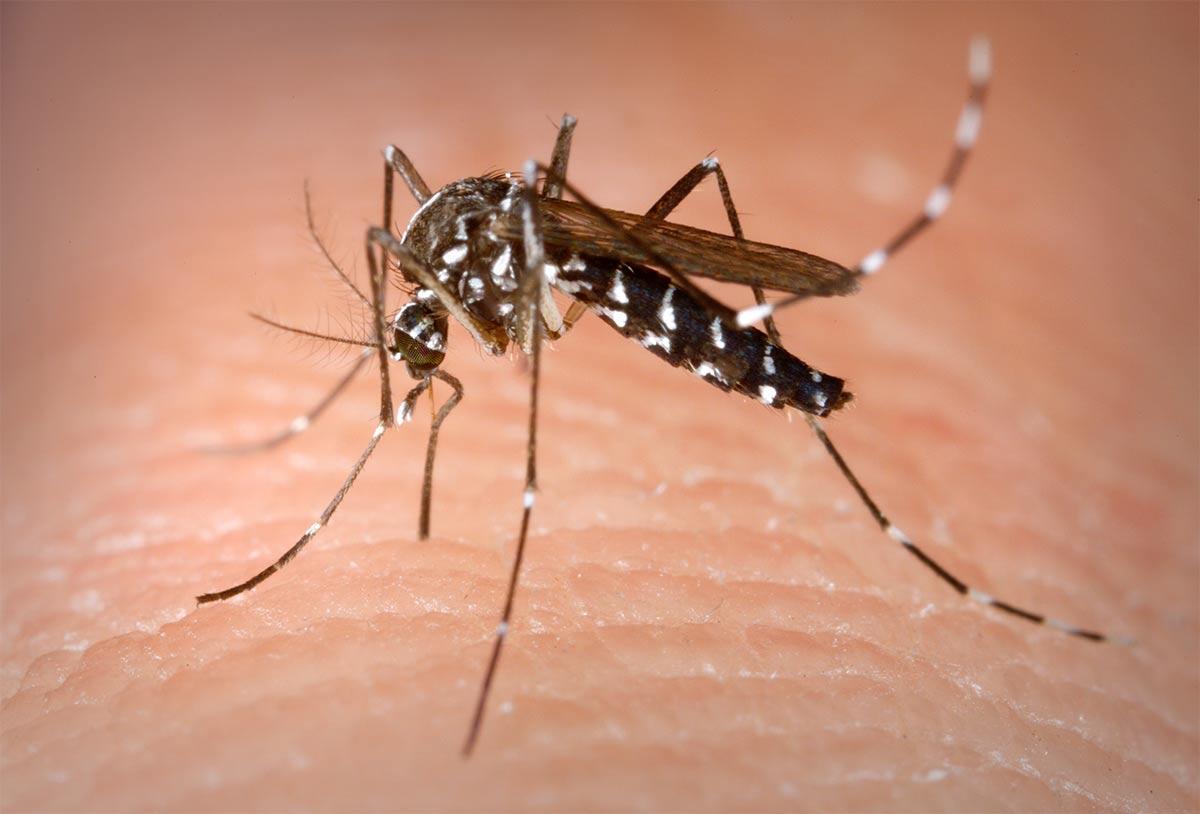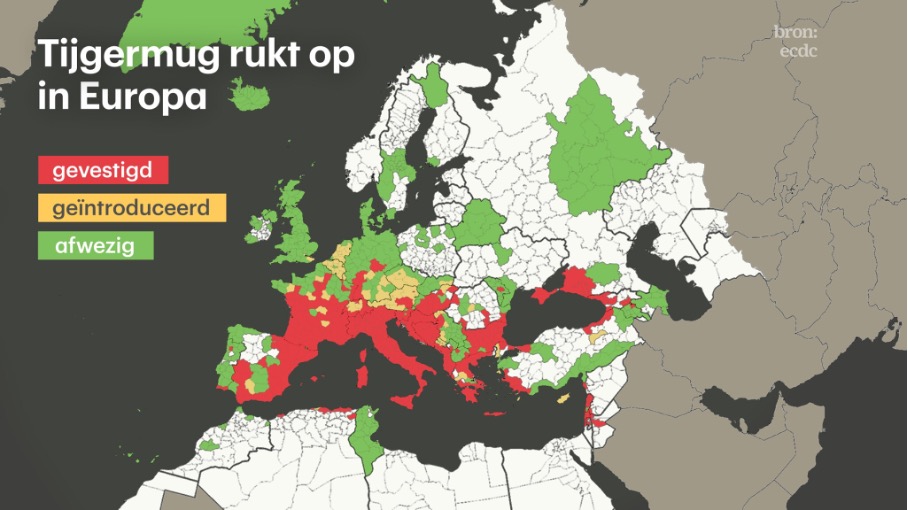Every year on August 20th, World Mosquito Day is celebrated, with this year’s focus on the Asian tiger mosquito. It’s a day that reminds us that mosquitoes, despite their small size, can have a significant impact on public health. But on this day, we also honor the groundbreaking work of Sir Ronald Ross, the British physician who unraveled the secret of the malaria mosquito and ushered in a new era in medical history.
A mosquito that has been receiving increasing attention in recent years is the Asian tiger mosquito (Aedes albopictus). This invasive species has spread across various parts of the world and is frequently spotted in Austria, Belgium, Germany, Greece, Hungary, and the Netherlands, among other places. It has now become permanently established in Cyprus and Slovakia.
In this article, we explain how to recognize the tiger mosquito, explore the potential dangers of the Asian tiger mosquito’s permanent presence in Europe, and answer some frequently asked questions about this mosquito.
Recognising the Asian tiger mosquito
The Asian tiger mosquito is native to Asia, as its name suggests. This mosquito is known for its distinctive black and white stripes on its body and legs, making it easy to spot. It is also known for its aggressive biting behavior, which often occurs during the day. This contrasts with many other mosquito species, which are primarily active at night.
If you manage to catch or kill a tiger mosquito, you can report it to the Netherlands Food and Consumer Product Safety Authority (NVWA).

Recognising the Asian tiger mosquito
Recognizing an Asian tiger mosquito bite
Recognizing an Asian Tiger Mosquito bite can be tricky, as reactions can vary from person to person. Generally, however, the bite exhibits similar symptoms to other mosquito bites. Redness, swelling, and severe itching may occur at the bite site. If, in addition to these symptoms, someone also experiences fever, headache, and joint pain, it’s important to seek medical attention, as these could be signs of mosquito-borne illness.
The Asian tiger mosquito in Europe
Originating in Southeast Asia, the tiger mosquito has become a modern traveler, entering Europe via international trade and travel routes. In recent decades, the Asian tiger mosquito has spread to various parts of the world, including parts of North and South America, Africa, and Europe.
This mosquito has now established itself in several countries on the European continent, posing a new challenge for public health authorities, given its ability to quickly and efficiently colonize new environments.
Vector-borne diseases and the tiger mosquito
Like the malaria mosquito, the tiger mosquito is known as a vector (“transmitter”) of several infectious diseases, including dengue fever, chikungunya, and the Zika virus. In Southern Europe, outbreaks of dengue and chikungunya have already led to serious health problems, while global concern has arisen over the Zika virus due to its links to birth defects. The emergence of these infectious diseases in Europe highlights the need for improved surveillance and mosquito control, not only for governments but also for individuals. It is essential that we better protect ourselves against mosquito bites, especially because the tiger mosquito is active during the day and thrives in urban areas.
Record number of Dutch people infected with dengue
In 2024, over 200 reports were made of Dutch people infected with dengue fever. According to Angela Looyé of Eurocross, it was unclear whether any Dutch people had contracted dengue fever in their own country. Most reports came from tourists in Indonesia, Thailand, and Curaçao, but there were also reports from places around the Mediterranean. Much closer to home!
According to the RIVM (Dutch National Institute for Public Health and the Environment), dengue is currently still considered an imported disease in the Netherlands. However, the tiger mosquito has been observed in more and more places in the country in recent years. This increase is related to the growth of populations in Southern Europe and the expansion of their habitat towards the Netherlands. This increases the risk of the mosquito being brought to the country (Dijkstra, 2024). However, the risk of local infection remains very small. To date, no indigenous dengue infection has been confirmed in the European Netherlands.
The Mediterranean connection
The Mediterranean serves as an ideal breeding ground for mosquitoes, including the tiger mosquito. The favorable climate and abundant water resources provide an ideal habitat for this mosquito. This has led to the tiger mosquito’s rapid spread in the region and increased the risk of local outbreaks of mosquito-borne diseases.
The role of climate change
The link between climate change and the rise of the tiger mosquito in Europe cannot be ignored. Rising temperatures and changing rainfall patterns have made it easier for this mosquito to colonize new areas. As a result, previously unsuitable areas may now be susceptible to its establishment.
Warmer summers and milder winters not only increase the tiger mosquito’s numbers but also extend its active season, increasing the risk of mosquito-borne diseases being transmitted. Furthermore, the increase in stagnant water due to increased rainfall creates additional breeding grounds, allowing the mosquito population to grow more rapidly. This increases the risk of mosquito-borne diseases spreading to areas where they were previously unaffected.
Possible dangers and impact in Europe
The arrival of the Asian tiger mosquito in Europe poses potential risks. Besides the irritation and nuisance caused by its bites, there is a risk of spreading mosquito-borne diseases. European health authorities are closely monitoring the spread of this mosquito and are working on preventive measures to reduce its potential impact. This includes reducing breeding grounds, advising people to protect themselves from mosquitoes, and monitoring potential disease outbreaks.
Challenges and opportunities for control
Combating the spread of the Asian tiger mosquito requires a coordinated and integrated approach. Traditional mosquito control methods, such as insecticides and larvicides, are not always effective against the tiger mosquito. The use of innovative strategies, based on scientific research, is essential to control this mosquito population and limit the spread of diseases. One example is sterilizing male mosquitoes and releasing them in at-risk areas, which can lead to a drastic decline in the mosquito population.
Mosquito monitoring and early warning systems
The importance of mosquito surveillance cannot be underestimated. Early warning systems help detect potential outbreaks and enable public health authorities to intervene promptly to limit the spread of diseases. It is encouraging that in several European countries, information about the presence of mosquitoes and ticks is now being included in weather reports. This allows residents to take personal measures to reduce mosquito nuisance, such as removing puddles around the house, using insect screens and mosquito nets, and applying insect repellent to exposed skin.
Research on mosquitoes
Research on mosquitoes and mosquito-borne diseases is essential for assessing potential risks and developing effective solutions. This includes understanding mosquito genetics, the interaction between mosquitoes and pathogens, and developing new mosquito control technologies. The work of pioneers like Ronald Ross paved the way for understanding the complex world of mosquitoes and diseases, and it’s up to us to continue this legacy in our fight against the Asian tiger mosquito and other dangerous vectors. Therefore, it’s only right that we reflect on this at least once a year on World Mosquito Day!
This day not only reminds us of the presence of mosquitoes and their impact on our world, but also highlights the rise of the Asian tiger mosquito in Europe and the importance of awareness and prevention. The aggressive nature of this mosquito and its potential to transmit diseases make it a worrying addition to the ecosystem. By remaining vigilant, working together, and taking appropriate measures, we can try to limit the spread of this mosquito and the potential health risks it poses.
How do you recognize an Asian tiger mosquito?
You can recognize the Asian tiger mosquito by the following characteristics:
- The tiger mosquito is small and its body is black and white.
- The ends of its hind legs are white.
- The tips of its palps (mouthparts near the proboscis) are white.
- A white stripe runs from the head up the back.
- Both the head and abdomen point downward.
What is the difference between a common mosquito and a tiger mosquito?
Distinguishing between a common mosquito and an Asian Tiger Mosquito isn’t always easy. Both have similar body shapes and behaviors, but there are some key differences. A distinguishing feature of the Asian Tiger Mosquito is the striking black and white stripes on its body and legs. This distinctive pattern makes it easier to identify. Furthermore, the Asian Tiger Mosquito prefers to be active during the day, while most common mosquitoes are primarily active at night.
What happens if you get bitten by a tiger mosquito?
A bite from an Asian Tiger Mosquito can cause itching and irritation, similar to the reaction to bites from other mosquito species. However, what makes the Asian Tiger Mosquito a concern is its role as a vector for several diseases. This mosquito can transmit diseases such as dengue, chikungunya, and the Zika virus. If a person becomes infected with one of these diseases, symptoms can range from a mild fever and muscle aches to more serious complications. It’s important to note that the Asian Tiger Mosquito must pick up these diseases by biting an infected person before it can transmit them to others.
What diseases can the Asian tiger mosquito transmit?
Besides viruses, tiger mosquitoes can also transmit parasitic worms to humans and animals. Diseases that tiger mosquitoes can transmit include:
- Chikungunya (mild fever and joint pain).
- Dengue fever (sudden fever, severe headache, joint and muscle pain).
- West Nile disease (fever, headache, meningitis).
- Zika fever (fever, temporary joint pain, and rash).
How can you prevent a tiger mosquito bite?
There are several ways to reduce the risk of mosquito bites. We’ve listed the most important tips below.
- Wear long, light, and airy clothing, such as long pants, a long-sleeved T-shirt, and socks.
- Spray exposed skin with an insect repellent containing DEET, Citriodiol®, or Icaridin.
- Eliminate potential breeding grounds. Do this by removing standing water in and around your home, such as buckets, flowerpots, and clogged gutters.
- Stay away from areas where mosquitoes have been spotted, especially during their active period. For tiger mosquitoes, this is from sunrise to sunset.
- Install screens on your windows and doors to prevent mosquitoes from entering your home.
- Sleep under a (treated) mosquito net. Because tiger mosquitoes are mainly active during the day, this tip is primarily effective for keeping other mosquitoes at bay.
Where does the tiger mosquito occur in the Netherlands?
The Asian Tiger Mosquito has unfortunately been spotted increasingly frequently in the Netherlands in recent years. The mosquito has gradually spread through international trade and travel. In the Netherlands, it is primarily found in urban areas, where the warmer climate and stagnant water provide ideal breeding grounds. Because the Asian Tiger Mosquito is known for its aggressive biting behavior and ability to transmit diseases, concerns have been raised about its potential impact on public health.
Source: nvwa.nl
What should you do if you see a tiger mosquito?
Have you seen an Asian tiger mosquito? Report it to the NVWA (Netherlands Food and Consumer Product Safety Authority) at www.nvwa.nl/muggen. Using the “Report exotic mosquito discovery” button, you can report the date and location of the mosquito and attach any photos.
(Source: NVWA)


